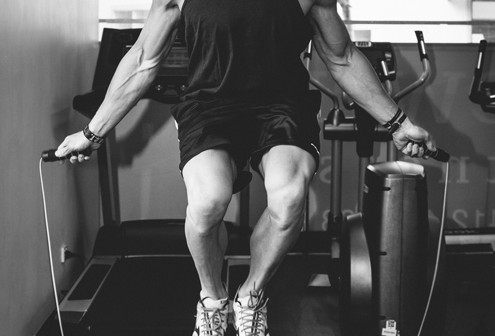Step away from the dumbbells and barbells because the kettlebell is here to stay in terms of improving your functional training capabilities and fitness levels. Functional training is a method that is being discussed on many internet fitness forums and there is a lot of ‘Bro-Science’ being bandied around by some of these websites. Therefore, this article will cut the wheat from the chaff, discussing what actually functional fitness is and how can training with kettlebells help to improve it. Please read on!
Functional Training
Over the past decade, there has been a shift in making training more functional. The revolution started with physical therapists and filtered its way into personal training and coaching. Functional fitness involves training for activities that we perform in our daily tasks, and simulating the common movements that are performed at work, home or in sports. The functional exercises have been designed to develop your strength which makes it easier/safer to perform everyday activities without getting injured. Below are some example of some of the activities that are simulated when functioning training:
- picking things up off the floor e.g. clothes and shopping
- putting things away over your head e.g. putting shopping away in cupboards over your head
- carrying items e.g. bags of shopping
- squatting down e.g. DIY
- reaching and rotating e.g. gardening and DIY around the house
Therefore, each exercise focuses on more than one body part, instead of using one muscle e.g. the bicep curl, all of the muscles work together to produce more compound movements e.g. the kettlebell bicep curl with a step up onto a box. This is an important concept because all our muscles depend on each other and they also work together during daily activities. Thus, by using more compound movements during the kettlebell session; your daily movements will become more energy efficient by using less energy and reducing stress placed on your body. The table below is an example of how kettlebells can be applied to a variety of functional movements:
Exercise
Movement Type
- Snatch
- Pushing
- Military press
- Pushing
- Floor chest press
- Pushing
- High pull
- Pulling
- Bent over rows
- Pulling
- Sumo high pulls
- Pulling
- Russian twists
- Twisting
- Wood choppers
- Twisting
- Ballet twists
- Twisting
- Squats
- Bending
- Lunges
- Bending
- Side bends
- Bending
# Please note there maybe some cross over in exercise and their primary movement categories e.g. front squats where you bend your knees to power up through your heels and then you push the kettelebell/s above your head.
The Benefits of Functional Training
Resistance type exercises that only use one muscle are important for building muscle mass but unfortunately they can cause ‘disproportion’. By adding functional exercises with kettlebells into your exercise routine, your balance, coordination and core stability will work together as a bodily unit, thereby enabling you to perform daily tasks a lot more efficiently. This will lead to the following health and fitness benefits:
- It makes daily tasks and activities a lot easier because the body is more conditioned
- Improves the overall musculoskeletal and joint function within the body
- Reduces your risk of injury and falling
- Enhances your quality of life
- Enhances stability, coordination and balance
- Develops strength in your muscle stabilizers e.g. shoulder, hip and core
- It boosts physical endurance
- Increases your resting metabolism because resting muscle requires more energy to function than fat
- Improves your posture by strengthening the lower back and core
- Helps to eliminate arthritic pain, back pain, upper extremity pain and joint pain e.g. the knee
- Improves range of motion at the joints e.g. the shoulder and hips.
The impact of functional training with kettlebells
Functional training with kettlebell/s works on different bodily movement planes e.g. frontal, sagittal and transverse, hitting different angles, recruits the muscle stabilizers as well as using the main muscle groups and the core. The kettlebell also has a unique design and it has a centre of gravity that is around 6-7 inches outside of your hand grip and this actually duplicates the forces used in daily activities such as carrying the shopping. It also improves your grip strength because of the increased activation of your forearm muscles.
In addition, the shape of the kettlebell allows positioning of the weight to be above your center of gravity. This has a positive effect in that it permits you to keep your arms/wrists in a neutral position and it is that concept that allows you to perform a greater range of functional moves for a longer period of time. Therefore, you can perform a larger amount of functional moves; this increases your functional fitness and its associated benefits a lot quicker than using dumbbells and/or barbells.
Kettlebell training also works all planes of your body unilaterally and this ensures that all of the major muscle groups are worked and there are no imbalances in the kinetic chain. An advantage of using kettlebells is that they engage the posterior kinetic chain and the muscles activated include the hamstrings, glutes, calfs and the core. For example by strengthening your glutes will prevent your erector spinae from overcompensating when performing functional every lifting movements.
Back pain is a major cause of absenteeism in the work place and one of the main benefits of functional training with kettlebell is that it strengthens your back in a variety of ways. Firstly, it helps to increase your hip flexibility; this produces a pelvic tilt and reduces the load on your lower back. The next key benefit is that strengthens the erector spinae and multifidus muscles which are important for posture and spinal stability. Last but by no means least it helps with bracing which is another important factor in spinal stability, good back health and injury prevention.
Try these kettlebell workouts


